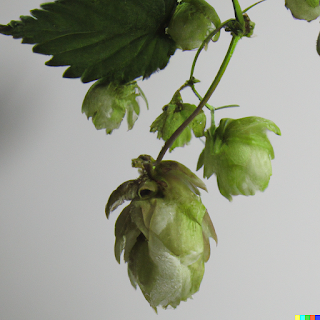While dry hopping does not have a direct impact on yeast metabolism, it can affect the yeast's ability to ferment sugars and produce alcohol. Hops contain compounds known as hop oils, which are composed of various terpenes and other volatile compounds. These compounds can inhibit yeast growth and fermentation if they are present in high concentrations.
One of the main terpenes found in hop oils is myrcene, which has been shown to have antimicrobial properties that can inhibit the growth of yeast and other microorganisms. In addition to inhibiting yeast growth, hop oils can also affect yeast metabolism by altering the yeast's gene expression.
 |
| Dry hop into beer wort like a Jedi Knight |
Recent research has shown that dry hopping can induce stress responses in yeast, which can lead to changes in gene expression and metabolism. Specifically, dry hopping has been shown to increase the expression of genes involved in oxidative stress response and energy metabolism.
In one study, researchers found that dry hopping with high concentrations of hops (greater than 2 g/L) resulted in a decrease in yeast cell viability and an increase in oxidative stress markers. However, at lower concentrations of hops (less than 1 g/L), there was no significant effect on yeast viability or oxidative stress.
Overall, while dry hopping does not directly impact yeast metabolism, it can indirectly affect yeast growth, fermentation, and gene expression through the presence of hop oils.
Brewers must carefully control the amount of hops added during dry hopping to ensure that the beer's flavor and aroma are enhanced without negatively impacting yeast metabolism.
How does a home brewer address this issue?
- Use a high-quality yeast strain: Using a healthy and robust yeast strain that is well-suited for the specific beer style can help ensure that the yeast can handle the stress of dry hopping.
- Control the hop dose: The concentration of hop compounds in the beer can have a significant impact on yeast metabolism and health. Careful control of the hop dose can help reduce the stress on the yeast and minimize the risk of off-flavors and aromas. This is fancy way to say do not over hop your beer!
- Monitor fermentation temperature: Yeast metabolism can be influenced by temperature, and higher temperatures can increase the risk of yeast stress. Maintaining a stable and appropriate fermentation temperature can help reduce the stress on the yeast during dry hopping.
- Use yeast nutrients: Yeast nutrients, such as yeast hulls or zinc, can be added to the wort to help improve yeast health and performance during fermentation. Zinc as a nutrient is a crucial part of beer brewing.
- Add hops in stages: Rather than adding all of the hops at once, adding them in stages can help reduce the overall stress on the yeast. This can be achieved by dividing the dry hop addition into multiple smaller additions, which can be added over several days.
All this is well and good but our personal experience suggests that one can make pretty good beers when dry hopping so I personally do not worry about the effects of dry hopping on my own beer!

0 comments:
Post a Comment